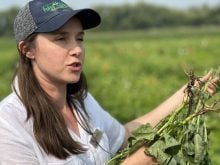There are a of things to consider when you’re planning long-term rotations: herbicide rotations, nitrogen needs, rainfall. How about adding fungus to that list?
The relationship between fungi in your soil and plant roots has a big impact on your crop health. This relationship can cause flax to be stunted when it’s grown in rotation after canola. Corn and sunflowers can also suffer when they’re planted on canola stubble.
“Following canola, we often see some interesting, funky growth responses,” said Dr. Mario Tenuta, soil science professor at the University of Manitoba. Tenuta was oan hand to talk about fungi at CanolaPALOOZA, a canola-based learning day hosted by the Manitoba Canola Growers and the Canola Council of Canada at Portage la Prairie, Manitoba, in June.
Read Also

Claas brings 1000 Series SP forage harvesters to Canada
In mid-August, Claas unveiled its new line of Jaguar forage harvesters at an event in Visalia, California, deep in the heart of that state’s dairy region.
Arbuscular mycorrhizal fungi
“It’s a story of the soil, and fungi,” Tenuta said.
The word “mycorrhiza” comes from the Greek words for fungus and root. Mycorrhiza is the symbiotic relationship between fungi in healthy soil and the roots of a plant. The fungi help the plants take up minerals and water; the plants provide the fungi with carbohydrates.
“Fungi have these hyphae,” Tenuta said, describing their branching structures. When the fungi are living near a plant, their hyphae penetrate into the plant root structures. The fine surface areas of the hyphae help the plants absorb nutrients.
“What they’re doing,” said Tenuta, “is they’re helping the plant by taking phosphorus from the soil, and transferring it through these hyphae, into the root system. They don’t kill the root. They’re not a parasite, and they’re not a pathogen.”
“Most plants, most of our crops will have this relationship with this fungi, and they will take phosphorus from the fungus,” Tenuta said. “But there are some crops, canola being one of them, which do not do this.” Canola doesn’t have this ability to colonize with the fungi, and gets its phosphorus in different ways.
Because they are not fed by a growing canola crop, the arbuscular mycorrhizal fungi (AMF) in the soil are starved for the season when canola dominates in the field. The following spring, the AMF population are reduced, so the next crop will not have as many fungi to work with in gathering phosphorus.
In early season growth crops, phosphorus is very important. Corn is highly dependent on phosphorus, so when corn follows canola in a rotation, yields can suffer. Wheat has a slightly lower dependency on phosphorus in the early season, but, the impact of following canola with wheat can still be seen in lab tests, and there may be a difference in yield.
“What we want growers to understand is this effect that, when they have canola in the rotation, following the canola some plants may be struggling to get phosphorus,” said Tenuta.
What can be done?
No-till farming practices can help to nurture the AMF in the soil. When there is tillage, the fungi can be damaged, and forced to re-grow again. “If you chop them up, and then you plant canola there, they’ll really get hammered,” Tenuta said.
Also, you can add phosphorus to the soil, to compensate for the lack of AMF.
Growing canola is hard on AMF populations, but thoughtful rotations can help them re-build. After canola, Tenuta suggested, grow something that’s not so dependent on phosphorus, something like rye, or buckwheat. “Buckwheat is fantastic,” he says. “Buckwheat doesn’t really need the mycorrhiza.”
Then, Tenuta said, “work your way up” in the rotation, giving the AMF time to recover before you seed flax.
In his extensive work involving soil and agriculture, Tenuta often finds canola standing out from the crowd. “Whenever we do studies with canola in rotations, and look at almost anything, we find that canola behaves differently.”
















